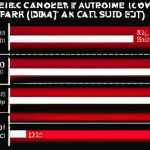diabetes is a common chronic disease that has affected millions of people worldwide. Effective prevention and treatment of diabetes involve a comprehensive approach, including lifestyle changes, medication, and regular health checks. In this article, we will focus on one vital aspect of diabetes management: how to effectively control obesity.
Obesity is a significant risk factor for the development of type 2 diabetes. Therefore, it is essential to identify methods that can help individuals maintain a healthy weight and reduce their risk of developing this disease. One such method is adopting a diet rich in nutrients, low in fat, salt, and sugars.
Firstly, let’s discuss the concept of a nutrient-dense, low-fat diet. This type of diet emphasizes consuming foods high in essential nutrients, like carbohydrates (in the form of whole grains, vegetables, and fruits), proteins (such as fish, lean meats, tofu, and legumes), and healthy fats (found in nuts, seeds, avocados, and olive oil).
To follow a low-fat diet effectively, consider the following tips:
1. Substitute unhealthy fat sources: Replace saturated and trans fats with healthier options such as monounsaturated and polyunsaturated fats. For example, use olive oil instead of butter or coconut oil when cooking.
2. Choose whole grains: Incorporate whole grains into your daily meals (like brown rice, quinoa, and oatmeal). They are rich in fiber, which can help you feel full for longer periods.
3. Consume plenty of vegetables and fruits: Aim for at least 5-7 servings of both fruits and vegetables per day. These serve as excellent sources of vitamins, minerals, and antioxidants while being low in calories and fat.
4. Opt for lean proteins: Select lean meats (such as chicken, turkey, and fish), tofu, legumes, eggs, and milk products with reduced-fat content. This will help keep your calorie intake lower while providing crucial nutrients for weight management and good health.
Now that we have established the foundation of a nutrient-dense, low-fat diet, it is essential to address the importance of reducing salt摄入量 in preventing diabetes. High sodium consumption has been linked to an increased risk of diabetes due to its negative impact on blood pressure and overall heart health.
To minimize salt intake:
1. Reduce processed foods: Processed foods are often high in sodium, so it’s best to avoid them as much as possible. Instead, focus on whole, fresh foods for better control over your diet.
2. Use fresh herbs and spices: Enhance the flavor of your dishes without adding extra salt by using various herbs and spices like garlic, cumin, oregano, basil, pepper, and lemon juice.
3. Don’t add salt before tasting your food: It’s often unnecessary to add salt before even trying a dish. By getting into the habit of tasting food before seasoning, you may become more sensitive to its natural flavors, making you less reliant on additional salt.
In addition to diet, regular exercise is crucial for controlling obesity and preventing diabetes. The American Diabetes Association recommends at least 150 minutes of moderate-intensity aerobic physical activity (such as brisk walking) per week, along with strength training exercises twice a week.
To incorporate more physical activity into your daily routine:
1. Take the stairs instead of the elevator whenever possible.
2. Park further away from your destination to encourage walking.
3. Use active transportation methods like cycling, walking, or jogging to get to work or run errands.
4. Participate in group sports or fitness classes for additional social and physical benefits.
To summarize, by following these guidelines—a nutritious, low-fat diet, minimizing salt intake, and regular exercise—you can effectively control obesity and lower your risk for diabetes. If necessary, consult with a healthcare professional to develop an individualized plan that works best for you. For those interested in learning more about diabetes prevention and treatment products, consider exploring this diabetes prevention supplement on Taobao.


